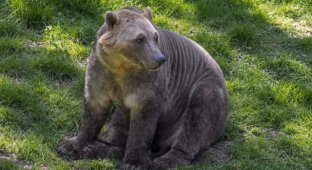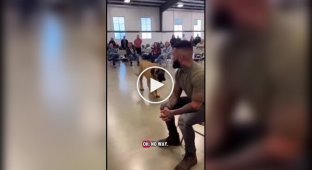Zhubron: an experiment by Soviet scientists to create a new species of pets (8 photos)
So, the parents of the beast with a funny name: the majestic forest giant - the bison and the most ordinary domestic cow. The species are very different both in appearance and in their way of life, but, nevertheless, they both belong to the genus of true bulls. 
When you have not decided who to be in life, and caught an existential crisis.
And this means that the horned ones have the same patterns of mating behavior, a comparable set of chromosomes and, in theory, can produce offspring - those very same bison. But everything is not so simple. 
Do you even know who my dad is? The largest animal in Europe!
Mother Nature has prudently come up with three serious restrictions, due to which bison-cow hybrids almost never happen in the wild. Let's skip the first and simplest one - location (forest/barn) and move on to more weighty arguments.
The second restriction is size. The average weight of a bison is roughly comparable to that of a cow: about 400 kilograms for a female and 600 for a male. But if these kilograms of well-groomed domestic animals include a fair share of fat, then wild ungulates have much less of this luxury, they are bony and muscular. Also, bison are much taller than cows - 140 centimeters against 190 for their wild counterparts. This is because the forest giants have a comparatively different anatomy: high withers, low-set neck and voluminous chest. 
Sometimes cows themselves run to the bison - like this one, for example. Compare the sizes!
So, if suddenly a domestic heifer casts aside all doubts and goes on a spree with wild bison, there is a high probability that she will simply die in childbirth. As breeders write, cows that carry hybrid calves have very weak labor activity or none at all. After all, the small zhubron inherits the features of its tall and broad-chested bison father - it simply does not fit in the mother's pelvic cavity. 
By the way, only cows are fertile in zhubrons. Bulls are most often sterile.
But if a naive domestic bull goes on a spree, he will face a third limitation - strength. As we have already said, cows are not distinguished by increased endurance and muscle mass. Plus they are smaller. And if bison walk through the forest all day, then the owner brings food to the lazy bulls. And in the wild, only the strongest and largest bull in the herd gets the opportunity to mate. Local bison simply will not allow a domestic bull to females! 
Yes, bison do not have such full muscles as meat breeds. But they are all used in business!
However, none of these three restrictions prevented the breeder Valitsky from obtaining 15 bison cows in the 1850s. Then his ideas for creating hybrids were continued in the USSR, in the Askania-Nova reserve. And after the war, intensive work was carried out in several reserves and zoos. Thus, by 1980, it was possible to breed about 600 heads of bison cows. 
What a lion this tiger is!
The reason for such interest in bison is economic. Bison by nature eat only grass, live in the open air, almost never get sick and gain a decent amount of weight. Cows can't do that - even the hardiest breeds of horned animals will still be inferior to wild animals and require more care. 
When you can see that you haven't skipped leg day.
But if breeders managed to create a large herd of bison, then why is no one breeding them now? According to official data, the project was shut down due to concerns about wild bison. Escaped hybrids can pose a serious threat to the already vulnerable genes of wild bison. The same problem was encountered in the West. There, they also breed a hybrid of wild and domestic cows - beefalo. But the situation with bison is much more critical: all modern wild horned animals were bred from the 12 surviving wild bison. So yes, their gene pool is really worth worrying about. 
Depending on the generation, bison can be more or less similar to their wild ancestors.
On the other hand, we all understand that money rules the world. If the Zhubroni really turned out the way they were intended - super hardy, unpretentious and early maturing, people would have found a way to breed these animals long ago, despite any restrictions. But the farmer faces many "buts". Almost always only cows are fertile among Zhubroni. Calves are born exclusively by caesarean section - the cow cannot give birth on her own. And the breeding work itself requires intellectual and financial resources.
A couple of Zhubroni individuals currently live in the Belovezhsky National Park. But whether they are engaged in the selection of hybrids purposefully is an open question.

























